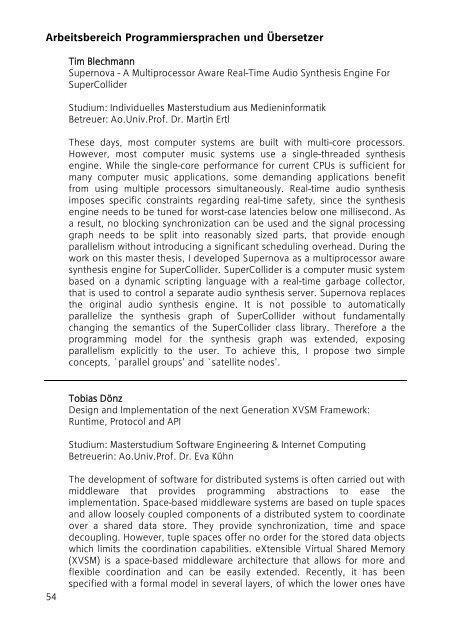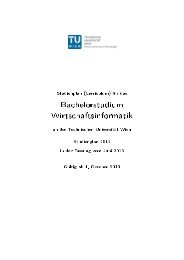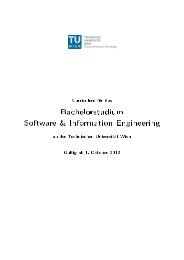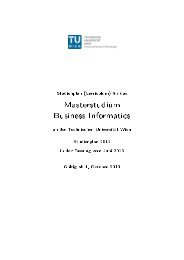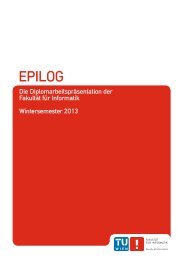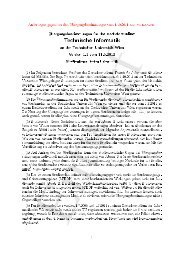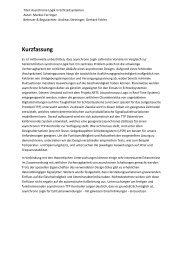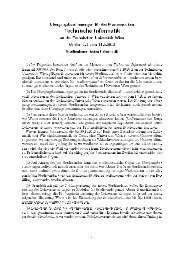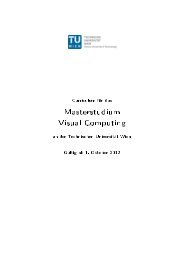Abstract-Band - Fakultät für Informatik, TU Wien - Technische ...
Abstract-Band - Fakultät für Informatik, TU Wien - Technische ...
Abstract-Band - Fakultät für Informatik, TU Wien - Technische ...
Erfolgreiche ePaper selbst erstellen
Machen Sie aus Ihren PDF Publikationen ein blätterbares Flipbook mit unserer einzigartigen Google optimierten e-Paper Software.
Arbeitsbereich Programmiersprachen und Übersetzer<br />
Tim Blechmann<br />
Supernova - A Multiprocessor Aware Real-Time Audio Synthesis Engine For<br />
SuperCollider<br />
Studium: Individuelles Masterstudium aus Medieninformatik<br />
Betreuer: Ao.Univ.Prof. Dr. Martin Ertl<br />
These days, most computer systems are built with multi-core processors.<br />
However, most computer music systems use a single-threaded synthesis<br />
engine. While the single-core performance for current CPUs is sufficient for<br />
many computer music applications, some demanding applications benefit<br />
from using multiple processors simultaneously. Real-time audio synthesis<br />
imposes specific constraints regarding real-time safety, since the synthesis<br />
engine needs to be tuned for worst-case latencies below one millisecond. As<br />
a result, no blocking synchronization can be used and the signal processing<br />
graph needs to be split into reasonably sized parts, that provide enough<br />
parallelism without introducing a significant scheduling overhead. During the<br />
work on this master thesis, I developed Supernova as a multiprocessor aware<br />
synthesis engine for SuperCollider. SuperCollider is a computer music system<br />
based on a dynamic scripting language with a real-time garbage collector,<br />
that is used to control a separate audio synthesis server. Supernova replaces<br />
the original audio synthesis engine. It is not possible to automatically<br />
parallelize the synthesis graph of SuperCollider without fundamentally<br />
changing the semantics of the SuperCollider class library. Therefore a the<br />
programming model for the synthesis graph was extended, exposing<br />
parallelism explicitly to the user. To achieve this, I propose two simple<br />
concepts, `parallel groups' and `satellite nodes'.<br />
Tobias Dönz<br />
Design and Implementation of the next Generation XVSM Framework:<br />
Runtime, Protocol and API<br />
Studium: Masterstudium Software Engineering & Internet Computing<br />
Betreuerin: Ao.Univ.Prof. Dr. Eva Kühn<br />
54<br />
The development of software for distributed systems is often carried out with<br />
middleware that provides programming abstractions to ease the<br />
implementation. Space-based middleware systems are based on tuple spaces<br />
and allow loosely coupled components of a distributed system to coordinate<br />
over a shared data store. They provide synchronization, time and space<br />
decoupling. However, tuple spaces offer no order for the stored data objects<br />
which limits the coordination capabilities. eXtensible Virtual Shared Memory<br />
(XVSM) is a space-based middleware architecture that allows for more and<br />
flexible coordination and can be easily extended. Recently, it has been<br />
specified with a formal model in several layers, of which the lower ones have


